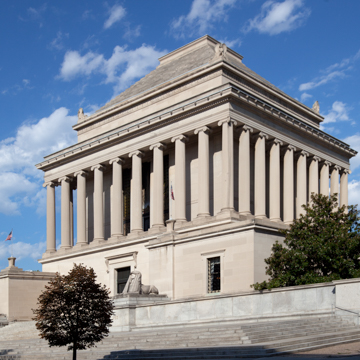|
Rispondi |
Messaggio 1 di 8 di questo argomento |
|
|
|
|
 Primo
Primo
 Precedente
2 a 8 di 8
Successivo
Precedente
2 a 8 di 8
Successivo
 Ultimo
Ultimo

|
|
Rispondi |
Messaggio 2 di 8 di questo argomento |
|
|
|
|
Rispondi |
Messaggio 3 di 8 di questo argomento |
|
|
|
|
Rispondi |
Messaggio 4 di 8 di questo argomento |
|
House of the Temple
From Wikipedia, the free encyclopedia
The House of the Temple (officially, Home of The Supreme Council, 33°, Ancient & Accepted Scottish Rite of Freemasonry, Southern Jurisdiction, Washington D.C., U.S.A.) is a Masonic temple in Washington, D.C., United States, that serves as the headquarters of the Scottish Rite of Freemasonry, Southern Jurisdiction, U.S.A.
Designed by John Russell Pope, it stands at 1733 16th Street, N.W., in the Dupont Circle neighborhood, about one mile directly north of the White House. The full name of the Supreme Council is "The Supreme Council (Mother Council of the World) of the Inspectors General Knights Commander of the House of the Temple of Solomon of the Thirty-third degree of the Ancient and Accepted Scottish Rite of Freemasonry of the Southern Jurisdiction of the United States of America." It was modeled after the tomb of Mausolus at Halicarnassus.
The Temple also holds a permanent large collection of materials related to Scottish poet and Freemason Robert Burns, one of the world’s largest, in its library holdings, which Library was the first public library in Washington, D.C.[1]
On May 31, 1911, 110 years after the founding of the Supreme Council, Grand Commander James D. Richardson broke ground on the spot where the House of the Temple now stands in Washington, D.C. Grand Master J. Claude Keiper, of the Grand Lodge of the District of Columbia, laid the cornerstone in the northeast corner on October 18, 1911.[2]
 House of the Temple rear view
The temple was designed by architect John Russell Pope, who modeled it after the tomb of Mausolus at Halicarnassus, one of the Seven Wonders of the Ancient World.[1] The building was dedicated four years later on October 18, 1915.
The building's design was widely praised by contemporary architects, and it won Pope the Gold Medal of the Architectural League of New York in 1917. In his 1920 book L'Architecture aux États-Unis, French architect Jacques Gréber described it as "a monument of remarkable sumptuousness ... the ensemble is an admirable study of antique architecture stamped with a powerful dignity." Fiske Kimball's 1928 book American Architecture describes it as "an example of the triumph of classical form in America". In the 1920s, a panel of architects named it "one of the three best public buildings" in the United States, along with the Nebraska State Capitol and the Pan American Union Building in Washington, D.C. In 1932, it was ranked as one of the ten top buildings in the country in a poll of federal government architects.[3]
 House of the Temple library
In 1944, the remains of former Sovereign Grand Commander and Confederate General Albert Pike were removed from Oak Hill Cemetery in Georgetown and placed in the House of the Temple.[4] The remains of Past Grand Commander John Henry Cowles were entombed in the temple in 1952, after his 31-year reign as Grand Commander.[5] The Temple also holds one of the largest collections of materials related to Scottish poet and Freemason Robert Burns in its library. When the library opened in 1870, it was the first public library in Washington, D.C.[6]
 Temple at night
The House of the Temple is designated as a contributing property to the Sixteenth Street Historic District, listed on the National Register of Historic Places in 1978.[7]
From 1990 to 2011, the temple hosted a community garden on its grounds, with the garden occupying about 0.25-acre (1,000 m2), divided into approximately 70 small plots tended by nearby residents.[8] In fall 2011, the Temple closed the garden in order to use the space to stage construction equipment for a building rehabilitation project.[9]
In popular culture
[edit]
In the 2009 novel The Lost Symbol by Dan Brown, the building is the setting for several key scenes.[10]
|
|
|
|
Rispondi |
Messaggio 5 di 8 di questo argomento |
|
Our 26th President Teddy Roosevelt was a Freemason.
He is Honored with a Memorial in Washington D.C. on an Island in the Potomac River. The Island was once called "MY LORDS ISLAND" and was known as "MASON ISLAND".
An interesting alignment occurs when a map of Washington DC is viewed looking to the EAST...
Place two diagrams of the Great Pyramid (with slopes of 51.51) on the map of DC with their corners touching and resting on the Roosevelt Memorial on "MASON ISLAND" ---
|
|
|
|
Rispondi |
Messaggio 6 di 8 di questo argomento |
|
-AA+A
1911–1915, John Russell Pope. 1733 16th St. NW

(Carol M. Highsmith Archive, Prints and Photographs Division, Library of Congress)

Scottish Rite Temple (Franz Jantzen)
☰ SEE METADATA
The mausoleum at Halikarnassos (353–c. 340 b.c.e.) was a model for many buildings in this period, including Masonic temples, because as one of the seven wonders of the ancient world it was associated with the beginnings of Western architectural traditions. The origins of freemasonry are linked to the lodges of medieval stonemasons and with a practice of architecture based on fundamental rules of the universe, with its most esoteric aspects expressed through a language of symbols. The definition of freemasonry as “a peculiar system of morality, veiled in allegory, and illustrated by symbols” explains why the buildings housing such organizations are themselves expressive of symbolic meaning.
Thrown down by an earthquake in the thirteenth century and quarried in the sixteenth century by the Knights of Saint John for the building of one of their castles, King Mausolos's tomb, a Hellenistic monument located on the Turkish coast, was the subject of numerous reconstructions by historians, archaeologists, and architects based on two ancient texts that describe its huge dimensions, colonnaded base, and stepped pyramidal top supporting a quadriga.
John Russell Pope's design, based on Newton and Pullman's 1862 restoration of the mausoleum, is centered on a nearly square site (217.5 by 212 feet) and raised above 16th Street on a podium with steps that extend the width of the block and that are organized according to arcane numerology. Three, five, seven, and nine steps converge on the central entry, which is guarded by Sphinxes, sculpted by Adolph A. Weinman, representing wisdom and power, contemplation and action. Thirty-six Ionic columns 33 feet high circumscribe the temple room, where the highest degree of freemasonry (the thirty-third) is conferred. The attic, marked by acroteria and the stepped pyramid, covers a square Guastavino dome; thus, the basic form above the base encloses a single volume. The compact base, with its expanses of smooth walls broken only by windows and doors, the peripteral colonnade set against nearly solid walls, and the faceted surfaces of the roof demonstrate Pope's unerring sense of balanced proportional relationships between masses and details. The light, monochromatic Indiana limestone is particularly well suited to the combination of planar surfaces and finely carved Greek and Egyptian details. Although Pope, with the advice of local architect and mason Elliott Woods, was responsible for incorporating some basic symbolism, the inscriptions and symbolic decorative details were planned by the grand commander of the lodge, George Fleming Moore, after the architectural design was completed.
The ground story is represented by the monolithic base on the exterior; on the interior an apsed atrium is ringed by offices, meeting rooms, banquet hall, and libraries. The atrium's form and decoration were intended as symbolic imitation of a Roman impluvium. Two sets of four massive Doric columns in a highly polished green Windsor, Vermont, granite establish a pathway leading to the apse on the east, where the main stair rises to the temple room. The oak-beam ceiling is painted in deep shades of red, brown, blue, yellow, and green, as are the walls in recesses behind the column screens. The decorative vocabulary mixes Greek frieze motifs and Egyptian hieroglyphics. The variation of rich and beautifully crafted materials continues in the main space. The temple room, a square with beveled corners that continue up into the dome, is constructed of limestone walls, Botticino marble dado, black and white marble floors, and a Guastavino tile dome. Windows are screened by Ionic columns set in antis made of green Windsor, Vermont, granite. Their gilded bronze capitals and bases echo the lavish use of gold or bronze in the entablature, windows, screens, and doors. The vault nearly doubles the height of the room, a proportional relationship that complements the subdued richness of the architectural surface. American architectural critic Aymar Embury so admired Pope's Scottish Rite Temple that he maintained, “Roman architects of two thousand years ago would prefer [it] to any of their own work.” 43
https://sah-archipedia.org/buildings/DC-01-MH12 |
|
|
|
Rispondi |
Messaggio 7 di 8 di questo argomento |
|
She is interchangeable with Columbia - the feminine personification of the United States. It was in the South Carolina state capital Columbia that Gov. Sanford revealed his Argentine affair... echoed by a train collision in the District of Columbia (Washington DC) on June 22:

June 22 DC Metro subway trains collide - 9 dead, 80 injured
Timeline:
June 18-24: Gov. Sanford missing/crying in Argentina
June 21: 'Impact' Part 1 on ABC; Prince William birthday
June 22: DC Metro Red Line trains in collision
June 23: US Moon probes (LRO/LCROSS) reach Moon
June 24: Gov. Sanford reveals Argentine affair
June 25: Death of Michael Jackson & Farahh Fawcett
'Metro' means 'meter' in Spanish, Italian, Portuguese, etc. The meter is historically defined as 1/10,000,000 of the distance between the North Pole and the equator through Paris, or in other words the Paris Meridian between the North Pole and the equator. The Paris Meridian is also the 'Rose Line' (an esoteric concept popularized by The Da Vinci Code) i.e. a 'Red Line'...

DC Metro Red Line = French/Columbian Rose Line
...traditionally implying the Blood Royal/Sangraal or the Marian/Columbian Bloodline of the Holy Grail.
In Bloodline of the Holy Grail Laurence Gardner writes of the House of Stuart, the royal bloodline to which Princess Diana and her children belong (pp. 344-5):
https://www.goroadachi.com/etemenanki/moonwalker.htm |
|
|
|
Rispondi |
Messaggio 8 di 8 di questo argomento |
|
Madeleine de France, Queen of Scotland, 1536
(Madeleine de France (1520-37) Queen of Scotland, 1536 )
|
https://www.meisterdrucke.us/fine-art-prints/Corneille-de-Lyon/80721/Madeleine-de-France,-Queen-of-Scotland,-1536.html
|
|
|
 Primo
Primo
 Precedente
2 a 8 de 8
Successivo
Precedente
2 a 8 de 8
Successivo
 Ultimo
Ultimo

|

